Monday, July 21, 2008
Memoir Monday: Drumroll please...
This summer I have been writing poems, not just for me, but I got brave enough to share with other people. I grew up overseas and the collection of poems I'm working on is based on some of my experiences trying to fit in and be comfortable in multiple cultures, yet still be who I am. The poems are set in Salem, Virginia, ChiangMai, Thailand, and Penang, Malaysia--three places I have spent significant time.
A few weeks ago I submitted some of these poems for consideration in the Francelia Butler Conference. My poems were chosen, which meant that I would be one of seven people with creative submissions to read aloud at the conference. Seven critical papers were chosen also.
I was a bundle of nerves because I knew there were poets in the audience, and I wondered if they would know I didn't know what I was doing.
This year's theme was a Dr. Seuss theme, because Philip Nel, author of The Annotated Cat:Under the Hats of Seuss and His Cats and Dr. Suess: American Icon, was the keynote speaker. Fellow students performed a Suessical Musical between readings, and it kept the day lively and fun. There was a silent auction, in which I won three things: a picture from The Tale of Despereaux, a lovely photograph of a clemetis donated by Sharon Dennis Wyeth, and a book of poetry by Billy Collins.
There is always a winner for each category: creative, critical, and art. After listening to the amazing stories crafted by my six other fellow readers, I knew I didn't stand a chance of winning. That's what's so amazing about Hollins--being in the company of so many good writers that you admire. I am always very impressed at how much good writing is produced in such a small group.
But when the winners were announced, they called my name! Yes, I won the Shirley Henn Award for Creative Scholarship. Wow! I was humbled and surprised!
Even if I hadn't won, this reading gave me a chance to share my work publicly. Several people came up to me during the break and shared how much they liked it. Two people introduced themselves: one is from Taiwan, and one lived in Malaysia, and both said they related to my poems. What a huge compliment. That's what I was hoping for. Other people were kind enough to just give me words of encouragement. Thank you! Thank you!
Hollins students are the ones who actually narrow down all of the submissions to a list of finalists. Then other writers actually judge the finalists. When I read the list of judges, I was so excited. The judges were: Bruce Coville, Steve Jenkins, Kerry Madden, Claudia Mills, and Janet Wong. I'm fans of all of their work, and it was an honor just to have them take the time to read something I had written.
The Memoir Monday prompt was to write about something that you did that you didn't think was possible. Believe it or not, this was it. I really never imagined I would share my poetry with anyone but my students. Now, thanks to a lot of encouragement from my friends at Hollins, I have the courage to share it with others.
Nonfiction Monday: Two Tales of Ben

Now and Ben: The Modern Inventions for Benjamin Franklin
Written and illustrated by Gene Barretta
Henry Holt, 2006
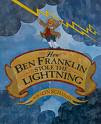
How Ben Franklin Stole the Lightning
Written and illustrated by Rosalyn Schanzer
Harper Collins, 2003
Recently I wrote about another book I used in my electricity unit in fourth grade science. In Virginia, fourth graders have to know about Benjamin Franklin, Thomas Edison, and Michael Faraday and their contributions to electricity. I have been using Schanzer’s book for a few years, but this year I discovered a new book about Ben Franklin.
Both of these books cover what my students really have to know: 1) that Benjamin Franklin proved that lightning was really electricity in his kite experiment, and 2) that he invented the lightning rod which protected buildings from damage and fires from lightning.
Now and Ben talks about how things we use today are things that Ben Franklin invented. So many things we use today began with Ben. Barretta sets up the book by saying “Now…” (insert one of the inventions we use today) and “Ben” (insert how Ben Franklin created this). The text is simple and short, but still goes through many of the inventions and contributions that we know Franklin for.
How Ben Franklin Stole the Lightning actually covers some of the same material, but it spends a little more time on Franklin and his experiments with electricity. Schanzer goes into detail about the kite experiment, the lightning rod, but also the way that people used to perform electrifying tricks—actually shocking people.
Both books are very light in tone. They are humorous to read and are nothing like reading a textbook. They present the information in a very interesting way.
This
 would be another great pair of books to use with kids to do “Text-to-Text Connections.”
would be another great pair of books to use with kids to do “Text-to-Text Connections.”Nonfiction Monday roundup is over at Anastasia Suen's Picture Book of the Day.
Friday, July 18, 2008
Francelia Butler Conference
I'm working on a collection of poetry about growing up between cultures, which I have posted some of those early drafts here and here.
Hollins has a conference every year where students can read both critical and creative works. Only seven students are chosen for each category. I was surprised to learn I'll be reading my poetry tomorrow for the conference. It's the Francelia Butler Conference and this year, Philip Nel, Dr. Seuss expert, will be speaking.
The last time I read for the Francelia Butler Conference was when I was working on my M.A. Thesis on Vinnie Ream in 2003.
This is the very first time I've read this poetry out loud to adults (except for my tutorial). I read my poetry out loud to my students frequently, but this public poetry reading is all new.
Thanks to Nikki, Sharon G., Elissa, Jenette, and Sharon Wyeth for supporting my poetry beginnings!
Poetry Friday: Monday Poetry Stretch
'Neath the shade tree
calls to me: Hide
here free. Read, write,
words find flight in
the sight of peace,
in notebook's crease you
will cease your pain.
by Marcie Flinchum Atkins
Today's Poetry Friday roundup is at Writing and Ruminating.
Monday, July 14, 2008
Butterfly garden
Memoir Monday: Crab Lookout
BTW, sorry for the sing-songy rhyme. I've been reading a lot of rhyme to my daughter lately and it's catching up with me.
Crab Lookout
It wasn't ants in his pants,
but he was doing a dance
my brother the swimmer, the sand castle builder,
had trouble in the depths of his swimming trunk filter
He pranced all around the sand castle moat,
He flopped his whole body in front of the boat
"Get them out! Get them out!" he yelled at our mom,
"There's nothing in there, now just remain calm."
They're biting my butt, I just cannot stand it,
You must get them out of my trunks, this minute.
She peeked in his shorts, as he wiggled some more,
Out popped three crabs right onto the shore.
"I told you! I told you!" he said in dismay,
then he ran off and returned to his play.
All day he kept checking to be sure the crabs had cleared out,
for the rest of the day, he was on crab lookout.
Jacksonville, Florida
Nonfiction Monday: Wired
 Wired
WiredBy Anastasia Suen
Illustrated by Paul Carrick
Charlesbridge, 2007
I loved this book so much, that my grade level recently bought it to use in our electricity unit. It’s very hard to find good trade books about electricity that are written on a kids’ level, give the basic information, but aren’t too basic. Our textbook is okay, but I wanted something more. I found it in this book.
This book begins by talking about what electricity is and how electrons dance. Then it explains how electricity gets from the power plant to your house. Details of step up- and step down-transformers are explained. It talks about substations, transmission towers, and even what all those wires behind a light switch are. The text is easy to read, but doesn’t talk down to kids. Suen even uses interesting language, so that it doesn’t feel like you are reading a textbook. The heading of each page actually becomes a poem if you read just the headings from beginning to end.
The illustrations in this book are pretty, yet informative. They are simple, but detailed. Contradiction? No, they are perfect for this book. They are not the common diagrams and drawings you see in a textbook. Instead they are acrylic mixed media illustrations that are pleasing to the eye, uncluttered, and very detailed for showing the different parts that is talked about in the text.
As a science teacher, I give it an A+. I will be using it every year with my electricity unit!

The author of Wired, Anastasia Suen, has the Nonfiction Monday Roundup at her blog.
Friday, July 11, 2008
Poetry Friday: Strawberry Haiku
Eaten before pies are made
By the little berry thief
by Marcie Flinchum Atkins
Tuesday, July 8, 2008
Poetry Stretch: "Coke Man"
Coke Man
The Coke man
parks his cart
by the school gates
waiting
for droves of children
hot, tired,
thirsty,
coins ringing
in their pockets.
Bottle pops open,
fizzy liquid flows into a
bag,
secured with a rubber band
in one corner,
a straw hole in the other.
I hand over my loose change,
and begin the hot walk home,
my bag of Coke bobbing
with each step.
ChiangMai, Thailand
Monday, July 7, 2008
Memoir Monday: A poem from my childhood
I pass by the red brick house
where I climbed in the dogwood tree,
crashed my sled into a fence,
caught frogs in the creek,
danced to the high school band,
transformed into Princess Lea,
hunted for Easter Eggs,
first got stung by a bee.
Now, it’s no longer my tree,
my fence,
my creek,
my band,
my imagination,
my eggs,
my hurts.
Someone else lives there.
I feel like someone crawled
underneath my skin
and tried to be me.
Copyright Marcie Flinchum Atkins, all rights reserved.
Head over to Two Writing Teachers to read other Memoir Monday posts.
Writing Challenges
Here's some of challenges I'm taking on:
1) Laurie Halse Anderson's Write 15 Minutes a Day Challenge. She gives writing prompts/exercises too.
2) Two Writing Teachers Memoir Mondays. I'll try to write some memoir piece and post it when I think it's postable.
3) Monday Poetry Stretch with The Miss Rumphius Effect.
Why am I taking the challenges? Well, I work well under structure and deadlines. So, if that means it will help "prime the pump", then so be it.
Do you know of another good challenge I should participate in? Leave me a comment.
Nonfiction Monday: Nic Bishop's Spiders
 Spiders
Spiders Written and photographed by Nic Bishop
Scholastic Nonfiction, 2007
Ever since this book began winning awards left and right, I knew I wanted to read it. I love interesting, beautiful nonfiction books. This book fits both of those descriptions. Perhaps I’ve lived in a hole, but this is the only book that I know of that I’ve read by Nic Bishop. I don’t think I have EVER seen a book with pictures as exquisitely detailed and fascinating as the photos in this book.
The book is all about spiders. It gives the basics about spiders: body parts, characteristics, etc. You know, all of those basic things I learned about spiders from E.B. White in Charlotte’s Web. However, Nic Bishop introduces readers to spiders and facts about spiders that I have never heard of. The text is not overly simple, but each spread is also not covered with heavy text. This is a book that kids will pick up, read and stare in awe at the pictures. It contains about a paragraph on each page about spiders. An entire page is a magnified picture of a spider. We see spiders’ eyes, hairs, and body parts up close and personal. Each picture is accompanied by captions about that specific spider.
The color layout is beautiful too. Each page with text has a colored background that coordinates with the colors in the photograph. It’s not a visually busy book. It’s simply laid out, but the pictures are anything but simple. Bishop is a master at photographing these hard-to-spot arachnids. In fact, in the back of the book he writes an author’s note about how he photographed the spiders. In some cases it was quite complicated.

Sunday, July 6, 2008
Haiku on a Sunday
No more grocery tomatoes
First taste of summer
What I've Been Up To...
Even though I haven't been blogging, I have been doing some fun things. Here are some things I've been doing:
* Strawberry picking--which gave us with lots of frozen berries and strawberry jam
* Blueberry picking--which garnished pies, frozen berries, jam, and syrup
* Sun bathing--at Virginia Beach and at our local pool
* Camping--at Lake Roberstson. Lots of relaxation, book reading, writing took place there.
* Cooking--I've been getting a produce box weekly from a local organic farm. I've also gone to the farmer's market every week, and we've been growing our own veggies. I have only been the grocery store for milk and the occasional thing like flour or sugar. It's a been a fabulously healthy, creative way to enjoy the summer. I have had to figure out new ways to cook things.
* Shopping--We went to the Green Valley Book Fair this last week. I got several new books (J. Patrick Lewis' new book The Brothers' War and Artist to Artist.
Friday, July 4, 2008
Which book are you?
So, which book am I? Anne of Green Gables. Probably the book I read over and over and over and over again as a kid. It was the book that prompted me to go to Prince Edward Island. This book influenced me in so many ways. What the description says about my personality, I don't necessarily agree with, but I think it's weird that this was THE book the quiz chose.
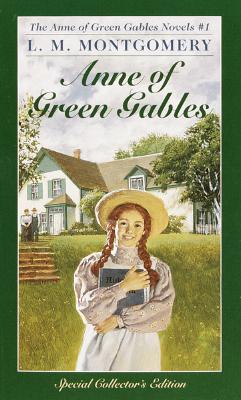
You're Anne of Green Gables!
by L.M. Montgomery
Bright, chipper, vivid, but with the emotional fortitude of cottage
cheese, you make quite an impression on everyone you meet. You're impulsive, rash,
honest, and probably don't have a great relationship with your parents. People hurt
your feelings constantly, but your brazen honestly doesn't exactly treat others with
kid gloves. Ultimately, though, you win the hearts and minds of everyone that matters.
You spell your name with an E and you want everyone to know about it.
Take the Book Quiz
at the Blue Pyramid.
Poetry Friday: Between the Lines
World Series
I watched the World Series on videotape
long after the first pitch landed in the catcher’s mitt,
long after the victory parties ended,
long after I read the final scores in the paper.
I watched the World Series on videotape anyway,
because it made me feel like an American
in a land where they play cricket.
Penang, Malaysia
by Marcie Flinchum Atkins
All rights reserved
Poetry Friday roundup is by In Search of Giants.
Friday, June 27, 2008
Poetry Friday: Twelve Rounds to Glory
 Twelve Rounds to Glory: The Story of Muhammad Ali
Twelve Rounds to Glory: The Story of Muhammad AliBy Charles R. Smith, Jr.
Illustrated by Bryan Collier
This book is for upper middle grade readers and young adult readers. But the layout of the book is like a picture book. It’s obviously not a picture book because of the length and the content. It is intended for older readers.
This is a biography written in verse. The book is divided into twelve chapters, or rounds. I was truly amazed at what a rhyming wizard Smith is. He has the poems rhyme, but they don’t appear sing-songy or cutesy. We learn much about Muhammad Ali through Smith’s verse. The dust jacket says that it was inspired by rap. It’s also written in second person almost like the author is talking directly to Ali about himself.
Bryan Collier has such a distinct style of illustrating. I enjoyed seeing the poems illustrated in full color. Many of the biographies in verse that I have read in the past weren’t illustrated in full color, so Collier’s illustrations added another dimension.
Smith writes about Ali’s fight with Joe Frazier:
“You have ascended the mountaintop
and must now reach its peak;
your body is tired
but your spirit is not weak.
Your rubbery legs
carry you to meet Joe,
but your weighted-down fists
manage to strike blow
after blow
after blow
after blow
to your opponent…”
This book won the Coretta Scott King Honor Award in 2008.
Hear Smith read some of his poems here.

Thursday, June 26, 2008
Candice Ransom on Transitional Readers
Candice Ransom has written over 100 books for children including Finding Day's Bottom, Tractor Day, Seeing Sky-Blue Pink, and her new series for children, Time Spies Series.
I read the first book in the Time Spies series, Secret in the Tower, before it was published. I immediately loved it for two reasons: 1) it would appeal to my students who were unable or unmotivated to read longer chapter books, and 2) it took place in Virginia and snuck in Virginia history. Since I teach fourth grade and fourth graders study Virginia History, this was a big draw for me. You can read a chapter of Secret in the Tower here.
So, what are transitional readers? They are kids who are past the easy reader books, but aren't ready for middle grade chapter books. They are newly independent readers. As a teacher, I'm glad Candice is trying to appeal to this age group. There are some kids who try to make that leap to regular chapter books and just can't plow through the entire book. They aren't ready. The Time Spies series books are ones that have chapters that can be read in one sitting, and have a "hook" at the end of the chapter, to make the reader want to keep reading.
Ransom describes her books as a mixed genre, combining adventure, fantasy, mystery, biography, history, set in a comtemporary setting, and put it all in a series. She says that this series is a tribute to "everyday fantasy" where a kid feels like something magic could happen to you. She pays homage to E. Nesbit and others. In this series, modern day kids go back in time to an important moment in history. But as Ransom says, she uncovers a piece of history in each of the books that hasn't been "done to death." The social studies teachers in my school were excited that Secret in the Tower talked about Jack Jouett, known as the "Paul Revere of the South" who warned Jefferson that the British wanted to capture him.
There isn't an author's note at the end of each books, because "kids don't read them." Instead there is a travel guide at the back of each book with the historical information in it.
The Time Spies series has a wonderful website with lots of information for kids. You can check it out here.
Other links:
Candice Ransom's website
Candice Ransom's blog
Wednesday, May 28, 2008
The Lotus Seed
 The Lotus Seed
The Lotus Seed By Sherry Garland
Illustrated by Tatsuro Kiuchi
Harcourt Brace, 1993
I stumbled across this book when I was looking for picture books to make “Text-to-World” connections with my students. It was used in a lesson in Strategies that Work by Stephanie Harvey and Anne Goudvis (2nd edition).
The book is about a young girl from Vietnam who wanted to remember the emperor when he lost his throne. So, she took a seed from a lotus flower in the emperor’s gardens to remember him by. When the Vietnam War tore apart her country, she moved to America, but she took the lotus seed with her to remember her country. She kept in near her family’s alter, wrapped carefully.
Many years later her grandson found the seed, wondered what it was, and took it outside and planted it without telling anyone. The girl, now a grandmother, cried and cried over her lotus seed. Soon it bloomed into a lotus flower and they were able to share the seeds among the family members to remember their home country of Vietnam.
I loved this story. I didn’t use it for a text to world connection lesson though. I am putting it in my files for next year to use this book with Red Butterfly, which I recently reviewed here.
If you are interested in other text-to-text connection books I use together, see my list here.
Tuesday, May 27, 2008
Bilingual Travel Books
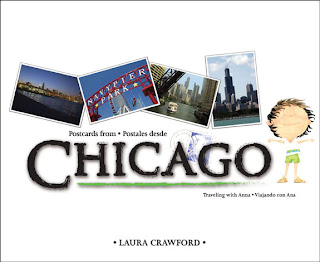
Postcards from Chicago: Postales desde Chicago
By Laura Crawford
Raven Tree Press, 2008
Postcards from New York City: Postales desde New York City
By Laura Crawford
Raven Tree Press, 2008
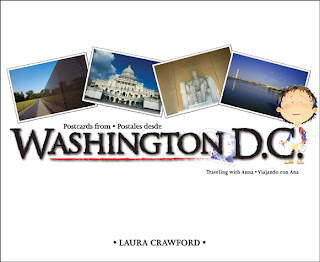 Postcards from Washington, D.C.: Postales desde Washington, D.C.
Postcards from Washington, D.C.: Postales desde Washington, D.C.
By Laura Crawford
Raven Tree Press, 2008
These books are part of a “Traveling with Anna” bilingual series by Raven Tree Press. Each book features a big city. Anna sends postcards to her friends and family from each city. Each spread consists of Anna’s postcard where she tells what she visited that day. The picture side of the postcard is featured of the real places. These photos are high quality and show what each tourist destination really looks like. Then each page features key facts about each place. They are short, but factual and easy to read. Anna’s postcards are more conversational and reveal some personal side to her travels.
The bilingual portions of these books feature the facts translated into Spanish. The postcards are written in English only. The facts feature more difficult words that might be hard to explain and understand for an ELL student, so it is helpful to have those facts translated.
Anna is featured through the book in drawings on each page.
I love this series of books because it blends fiction and non-fiction, Spanish and English. There are so many things that could be done with these books in the classroom. What helps is that they feature interesting, updated pictures, kid-friendly facts, and a simple, uncluttered layout.
Friday, May 16, 2008
Mosaic of Thought
 This past semester at school I have been part of a Teachers as Readers group reading Mosaic of Thought by Ellin Oliver Keene and Susan Zimmerman. It has really changed the way I think about reading and the way I plan for reading. I have been doing a series of lessons on Making Connections (text to self, text to text, and text to world). During that time, I compiled books that I used in my literature circles and in guided reading groups. I used these books with fourth graders, but keep in mind, you could adapt them to any grade level. I have posted the lists on the menu bar to the right. Each list is a PDF file, so they will be easy to download and open.
This past semester at school I have been part of a Teachers as Readers group reading Mosaic of Thought by Ellin Oliver Keene and Susan Zimmerman. It has really changed the way I think about reading and the way I plan for reading. I have been doing a series of lessons on Making Connections (text to self, text to text, and text to world). During that time, I compiled books that I used in my literature circles and in guided reading groups. I used these books with fourth graders, but keep in mind, you could adapt them to any grade level. I have posted the lists on the menu bar to the right. Each list is a PDF file, so they will be easy to download and open.
Wednesday, May 14, 2008
Bilingual Books: Paco and the Giant Chile Plant
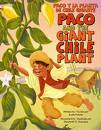 Paco and the Giant Chile Plant: Paco Y La Planta De Chile Giganta
Paco and the Giant Chile Plant: Paco Y La Planta De Chile GigantaBy Keith Polette
Illustrated by Elizabeth O. Dulemba
Raven Tree Press, 2008
This is a bilingual retelling of Jack and the Beanstalk. It is set in the Southwestern United States. The text is told in English with a lot of Spanish words embedded in the text. Readers who are bilingual will enjoy this tale that flips back and forth between Spanish and English. Students who are somewhat familiar or not familiar at all with Spanish will be able to use the glossary at the back of the book or discover the meaning of the word from the context of the sentence. The Spanish words included are mentioned in context and highlighted in red.
Paco and his mother need money, so they must sell their cow. Paco sells the cow to a man who gives him seeds in exchange for his cow. He plants the seeds to the chile plant and thus the Jack and the Beanstalk story begins. Here is an excerpt from the story where Paco meets the man who gives him the seeds:
Paco harnessed la vaca and led it down the dusty road.
At a dip in the dusty camino, Paco met an old man with bright eyes. Los ojos del viejo twinkled like stars. He held a walking staff and a small bag. El Viejo said, “Good afternoon, joven. That is a fine vaca, young man.”
“Buenos tardes, señor,” replied Paco. “Si, yes, it is a fine cow, but I must sell her. My mother and I have no money.”
This Jack and the Beanstalk story bears much resemblance to the traditional version, but of course a Mexican-American flare has been added. I especially love the surprise ending.
Elizabeth O. Dulemba’s digital illustrations give it an animated movie feel. Ms. Dulemba has lots of freebies on her website connected to this book. There are coloring pages (which she also features weekly on her blog), wallpaper, recipes, and a word search.
I would recommend this book to teachers and librarians who have bilingual children in their classrooms.
Friday, May 2, 2008
Poetry Friday: Boshblobberbosh
 Boshblobberbosh: Runcible Poems for Edward Lear
Boshblobberbosh: Runcible Poems for Edward LearBy J. Patrick Lewis
Illustrated by Gary Kelley
Harcourt, 1998
I have recently begun a fascination with Edward Lear since I was trying to teach my students about limericks. I stumbled across this picture book biography of sorts by J. Patrick Lewis. The story is told in poems as a tribute to Mr. Lear. Lewis includes an author’s notes with a few facts about Lear’s life. Then in the back of the books there are notes on each poem and how it relates to something in Lear’s life. And yes, Lewis includes a few limericks himself.
The one I will share today is “A Day in the Life”. It has a companion poem “A Night in the Life” in the book.
A Day in the Life…
Mr. Lear
Wakes at ten
Walks six miles
Paints a glen
Points his cat
Home again
Picks an olive
Plucks a flower
Takes a bath
By thundershower
Hears the cuckoo
Cluck the hour
So at four
Sips his tea
Takes a nap
Later
he
Tickles high
Society
Pats his bed
Snuggles in
Opens
With a grin
Reads a book
By Tennyson
Lays it down
Wonders long
Understands
What is wrong
Hums a little
Silly
song
Hums a little
Silly song
Hums a little
Silly…
Wednesday, April 30, 2008
What I've Been Reading: March and April 2008
March
Picture books
Doctor Ted by Andrea Beaty, illustrated by Pascal Lemaitre (my review here)
The Other Side by Jacqueline Woodson
Middle Grade
Steal Away Home by Lois Ruby
The Willoughbys by Lois Lowry
The Higher Power of Lucky by Susan Patron
Young Adult
The Game of Sunken Places by M.T. Anderson
A Pack of Lies by Geraldine MacCaughrean
The Boy Who Dared by Susan Campbell Bartoletti (my review here)
The Princess Bride by William Goldman
The Last Book in the Universe by Rodman Philbrick
Rereads
Al Capone Does My Shirts by Gennifer Choldenko
Hitler Youth by Susan Campbell Bartoletti
Out of the Dust by Karen Hesse
April
Picture books
City Lullaby by Marilyn Singer
Nettie’s Trip South by Ann Turner
Stand Tall, Abe Lincoln by Judith St. George
The Secret of the Great Houdini by Robert Burleigh, illustrated by Leonid Gore
Cinderella’s Rat by Susan Meddaugh
Nothing Ever Happens on My Block by Ellen Raskin
Jazz Baby by Carole Boston Weatherford, illustrated by Laura Freeman
So Few of Me by Peter H. Reynolds
The Dot by Peter H. Reynolds
The Butterfly by Patricia Polacco
Dolley Madison Saves George Washington by Don Brown (my review here)
Young Jim Thorpe: Bright Path by Don Brown
Red Butterfly: How a Princess Smuggled the Secret of Silk Out of China by Deborah Noyes, illustrated by Sophie Blackall (my review here)
Poetry
Family Reunion by Mary Quattlebaum
Boshblobberbosh: Runcible Poems for Edward Lear by J. Patrick Lewis
Jesse Owens: Fastest Man Alive by Carole Boston Weatherford, illustrated by Eric Velasquez (my review here)
Mother Goose’s Little Treasures collected by Iona Opie, illustrated by Rosemary Wells (my review here)
Nonfiction
Miracle: The True Story of the Wreck of the Sea Venture by Gail Langer Karwoski
Ox, House, Stick: The History of Our Alphabet by Don Robb, illustrated by Anne Smith
What Do You Do When Something Wants to Eat You? By Steve Jenkins (my review here)
Vulture View by April Pulley Sayre, illustrated by Steve Jenkins
Young Adult
Haroun and the Sea of Stories by Salman Rushdie
Adult
Eat, Pray, Love by Elizabeth Gilbert
Made from Scratch: A Memoir by Sandra Lee
Salem Falls by Jodi Picoult
Red Butterfly
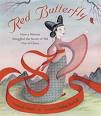 Red Butterfly: How a Princess Smuggled the Secret of Silk Out of China
Red Butterfly: How a Princess Smuggled the Secret of Silk Out of China By Deborah Noyes
Illustrated by Sophie Blackall
Candlewick, 2007
First of all, I must say this book is stunning. The illustrations look like an intricate Chinese painting. The details are beautifully imagined and portrayed. I picked this book out because I just fell in love with the illustrations. When I got the book home, I noticed it was on my “to read” list from a few months ago. I love when that kind of serendipity happens at the library.
You can visit Sophie Blackall’s website for some samples of her work from this book.
For as beautifully as this book is illustrated, it is matched by poetic writing that also brings out the beauty of this story.
The story is about a young girl in China who loves the silkworm that feeds on the mulberry tree on her father’s land. China is known for its prized silkworms and the thread it provides. But the young girl is soon to be married off to royalty in Khotan, and she is sad because she will miss her silkworm and her beautiful land. The red butterfly is her outfit that makes her look like a butterfly when her arms are outstretched. She sneaks some silkworms, some leaves, and some seeds of a mulberry tree in her hair and carries it off to her new home.
Here is a passage by Noyes that describes the beauty of the land:
“In my father’s kingdom
there are many splendors.
As we cross the wide
countryside
to the summer palace,
sunbeams slice through dark
woods,
spilling on moss. Monkeys wail
in maple groves along the
river.
Sparrows peck mud
for their nests.”
I just wanted to read parts of this book over and over again to soak up the poetry of the story. Mixed with the illustrations, this is one of my favorite books I have read in a long time!
This story is based on a true story and the author’s note in the back explains the history behind the story.
Monday, April 28, 2008
Nonfiction Monday: What Do You Do When Something Wants to Eat You
 What Do You Do When Something Wants to Eat You?
What Do You Do When Something Wants to Eat You? Written and illustrated by Steve Jenkins
Houghton Mifflin, 1997
I don’t know HOW I have missed this book before. It was published in 1997!! And I just discovered it a few weeks ago. I love Steve Jenkins’ books. They are great for many ages, from toddlers who love the pictures and the shorter text, to upper elementary readers, who love to read the fine print full of facts, and really still love his illustrations.
This book is about animal defense mechanisms. What do animals do when something tries to eat them? Well, Steve Jenkins chooses animals that kids will know, like the octopus that squirts black ink and the puffer fish who puffs out. But he also chooses lesser known facts that kids will find interesting like this one: “The basilisk lizard is known in South America as the Jesus Chris lizard. It can escape its enemies by running across the surface of ponds and streams, using its large feet and great speed to keep it from sinking into the water.”
This book has Jenkins stunning signature cut paper collage illustrations. It doesn’t include extra facts at the back of the book or within the text, like many of his other books do. Still, a fun, fact-filled read. I will be us
 ing this with my fourth graders in my animal adaptations unit.
ing this with my fourth graders in my animal adaptations unit. Friday, April 25, 2008
Poetry Friday: Jesse Owens, Fastest Man Alive
 Jesse Owens: Fastest Man Alive
Jesse Owens: Fastest Man Alive By Carole Boston Weatherford
Illustrated by Eric Velasquez
I recently got to meet Carole Boston Weatherford at the VSRA conference. I really enjoyed hearing the stories behind many of her books. One of my favorite genres is picture book biographies. And I really enjoy poetry. Weatherford has composed all three into one book.
Each poem in this book tells the story of Jesse Owens. It doesn’t begin with his childhood, but it does give us a glimpse into where he was from. Jesse Owens was a track and field star during the 1936 Olympics in Berlin, at a time when Hitler was the dictator of Germany. Jesse Owens crushed Hitler’s expectations of the Germans sweeping the Olympic medals. Weatherford gives some historical background in her author’s note.
Here is one of Weatherford’s poems about the day Jesse Owens received his fourth gold medal.
Medal #4: The 400-Meter Relay
With three gold medals,
you could rest on your records,
but the Germans have saved
their fastest for last.
Your coaches need
a secret weapon—
you.
You run the first leg of the relay,
passing the baton and the lead
to the next runner.
By the finish line, the race
and your fourth medal are won.
Who’d have thought
that a sharecropper’s son,
the grandson of slaves,
would crush Hitler’s pride?
Who knew that you would trample
German might like a clod of dirt
in a field of glory?
Who’d have thought your star
would burn so bright?

Thursday, April 24, 2008
Eric Rohmann: Day 6

By Eric Rohmann
Knopf, 2008
I had to wait FOREVER to get my paws on a copy of this book at my local library. Someone else snatched it up before I did. This book is perfect for preschoolers.
Four little kittens are talking about snow in the middle of the summer. Three of them are dreading and worrying about the coming snow. The fourth kitten can’t wait. Then the fall comes. They continue to talk about snow with trepidation. The fourth kitten is so excited about the possibility. Finally, the snow comes. The fourth kitten jumps right out into the snow and has a rollicking good time. Of course, the others follow out and enjoy themselves too. It is a simple story, told with fun language that reminds me of little kittens frolicking.
Here’s an excerpt of the short, frolicking dialogue that takes place between the kittens:
When autumn winds ruffled the trees, the first kitten said, “Soon the snow will
fall and fall. We’ll be cold and wet and snow will cover everything!”
“Piles and drifts!” said the second kitten.
“Heaped to our whiskers,” said the third kitten.
Still the fourth kitten said, “I can’t wait.”
Eric Rohmann: Day 5

My Friend Rabbit
Written and illustrated by Eric Rohmann
Roaring Brook Press, 2002
This book won the Caldecott Medal in 2003. I remember buying this book and thinking: WOW. The illustrations are so bold and so toddler-minded. The text is simple and has a wonderful cadence to it. Rabbit’s toy airplane is stuck in the tree. He tries to come up with an inventive way to get it out, so he gathers, pushes, and shoves his animal friends on top of one another until they form a tall tower. This of course comes crashing down!
I love his use of perspective in the illustrations. On one spread rabbit is in the far corner of the page pulling on an elephant’s tale. Everything looks so small and the spread is rather bare. Then the next page explodes with a giant elephant taking over the entire spread. When all of the animals are piled on top of one another, you must turn the book vertically to view it correctly. Then they all come crashing down and we see wild animal eyes of every sort as they looked surprised, shocked, and flabbergasted. Then we see those same animal eyes all glaring at rabbit. Every spread is full of surprises and delight. The illustrations are appealing to a very young audience. In fact, a non-reader could figure out what is going on in the story even without the text.
A romping fun read and so well-deserving of the Caldecott Award.
Tuesday, April 22, 2008
Eric Rohmann: Day 4
 Pumpkinhead
Pumpkinhead By Eric Rohmann
Knopf, 2003
This is a funny book. It would appear on the outside to be a book that really, really young kids would like. However, I think some upper elementary kids would find it funny. There is a boy name Otho who has a pumpkin for a head. His family doesn’t seemed to be worried by it, but one day a bat comes by and wants to scoop up the pumpkin for a place to live. He seizes upon Otho’s head and runs away with it. Otho’s head makes quite a journey. It flies in the air, gets dropped into the ocean, gets eaten by a fish, is found by a fisherman, and finally bought by his own mother at the fish market. It’s an unusual tale. It could be read any time of the year, but would be particularly interesting at Halloween with the bat and the pumpkin (even though it’s not about Halloween). The language Rohmann uses is interesting and would not bore an older reader.
The book itself is small in size and square. Rohmann’s illustrations are small boxes with heavy lines (like My Friend Rabbit--to be reviewed tomorrow). The font cover has a cut out that reveals the pumpkinhead on the title page. The book was an unexpected (and pleasant) surprise.
Monday, April 21, 2008
Eric Rohmann: Day 3
 Time Flies
Time FliesIllustrated by Eric Rohmann
Crown Publishers, 1994
This wordless picture book begins when a bird is inside of a museum where dinosaur skeleton exhibits are displayed. The bird flies around and suddenly the dinosaur is no longer just bones, but a full living creature. The setting changes to a land full of dinosaurs of all kinds. The bird flies around among the dinosaurs until he gets eaten by a dinosaur. Then the dinosaurs slowly began to change back to skeletons.
This book will delight little dinosaur lovers.
Nonfiction Monday: Dolley Madison Saves George Washington
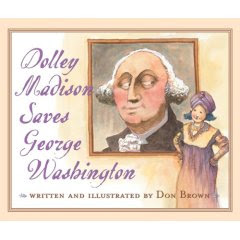 Dolley Madison Saves George Washington
Dolley Madison Saves George WashingtonBy Don Brown
Houghton Mifflin, 2007
I love picture book biographies. I especially love picture book biographies that don’t follow the traditional biography route. In other words, they don’t tell about the person from birth to death, but rather pick one or two really interesting moments of that person’s life and share that in a picture book. Not that I have anything against the traditional biography. It is one of my favorite genres, but I think picture book biographies make kids really think. They “explode a moment” in Barry Lane’s terms.
This book is no exception. The title alone makes the reader wonder how Dolley Madison, a first lady, save our first president. Why, she saved his portrait of course! Don Brown tells about what most people think of when they hear Dolley Madison’s name: “Everybody talked about Dolley Madison. They talked about her charm and grace. They talked about her beauty, her stunning gowns, and her delightful banquets.” (1). But Don Brown shows what a strong lady Dolley Madison was.
During the War of 1812, when the British were burning Washington, Dolley Madison wasn’t the first person to leave. Instead she stayed behind and ordered that the portrait of George Washington by Gilbert Stuart be saved. The portrait and the historical significance are pointed out in the text. So George Washington WAS saved by Mrs. Madison and returned to the White House years later, where it still hangs.
If you are a history buff, or just love a good picture book biography, you’ll lov
 e this book.
e this book. Sunday, April 20, 2008
Eric Rohmann: Day 2
 Clara and Asha
Clara and AshaWritten and illustrated by Eric Rohmann
Roaring Brook Press, 2005
Amazing things happen when it gets dark. Just as in The Cinder-Eyed Cats where animals move around while we sleep, Clara and Asha is a tale of a girl and her animal friends that visit at night. Clara opens her window at night and Asha, a fish she met as a stone in a park water fountain, comes to visit her. Asha has been her imaginary friend and has been with her on many adventures including Trick-or-Treating and snowman making. Asha even takes Clara on a night flight through the sky.
This book celebrates the imagination of children and their connection with the world. Children are so good at bringing the concrete to life. This book shows how much fun imaginary friends are. Rohmann’s illustrations are large and beautiful. He is an ace at flying fish.
Saturday, April 19, 2008
Eric Rohmann: Day 1
 The Cinder-Eyed Cats
The Cinder-Eyed CatsWritten and illustrated by Eric Rohmann
Crown Publishers, 1997
I have read some amazing books lately where kids go to imaginary lands. This one is one of the books. It opens with a little boy climbing into a boat in the sky. He sails away in the sky to an island. On this island there are cinder-eyed cats. At night the creatures from the sea rendezvous with the cinder-eyed cats and the boy. The boy gets to watch as the creatures intermingle only until the sun comes up. The little boy sails back home in his flying boat.
The illustrations are large and make the animals appear large and the boy just a small observer in the great big world. I love the fish illustrations and there is even a fish sculpted into the sand. Rohmann illustrates another fish like this in his book Clara and Asha (to be featured tomorrow).
Friday, April 18, 2008
Poetry Friday: Mother Goose's Little Treasures
 Mother Goose’s Little Treasures
Mother Goose’s Little Treasurescompiled by Iona Opie
illustrated by Rosemary Wells
Candlewick, 2007
This little collection of Mother Goose rhymes contains some rhymes that readers might not be familiar with. I really love the illustrations by Rosemary Wells. This would make a great gift for a toddler along with Here’s a Little Poem edited by Jane Yolen and Andrew Fusek Peters.
I share two from Mother Goose today:
What the Goose Thinketh
When the rain raineth
And the goose winketh,
Little knows the gosling
What the goose thinketh.
Little Old Dog Sits Under a Chair
Little old dog sits under a chair,
Twenty-five grasshoppers
Snarled in his hair.
Little old dog’s beginning to snore;
Mother she tells him
To do so no more.

Thursday, April 17, 2008
Fall in love with Pippi all over again!
 Pippi Longstocking
Pippi LongstockingBy Astrid Lindgren
Illustrated by Lauren Child
Translated by Tiina Nunnally
Viking, 2007
I love this new translation and illustrated version of Pippi Longstocking. It had been a very long time since I read the “original” Pippi Longstocking, so I remembered very little about it. I was intrigued by this version simply because of the illustrations by Lauren Child. I really like Lauren Child’s style and I wanted to see what she would do with this classic book.
This will bring Pippi to a whole new generation who will fall in love with her and her spunk. It is a new translation. The story line remains the same, but as far as I can tell, the changes in wording are there but minute (from a quick glance comparing the two). It is an oversized chapter book, almost double the size of the original translation I got from the library. It gives Lauren Child room to illustrate and also provides some white space so that the text doesn’t appear heavy. This has great kid-appeal. The text looks manageable and is enlarged and played with in many areas. Some whole pages are illustrations and sometimes the text just goes right around the illustrations.
I loaned my copy to a friend’s second grade daughter and she loved it! If you are looking for a great gift for a 2nd-4th grade girl, I would highly recommend this version.
Check out Lauren Child's website
Virginia Readers' Choice High School List
The Arrival by Shaun Tan
The Christopher Killer: Forensic Mystery 1 by Alane Ferguson
The Glass Castle by Jeannette Walls
The Last Knight by Hilari Bell
Life as We Knew It by Susan Beth Pfeffer
Light Years by Tammar Stein
A Room on Lorelei Street by Mary E. Pearson
The Rules of Survival by Nancy Werlin
Scrambled Eggs at Midnight by Brad Barkley and Heather Hepler
The Trap by John Smelcer
Virginia Readers' Choice Middle School List
Adam Canfield of the Slash by Michael Winerip
Airborn by Kenneth Oppel
Black Duck by Janet Taylor Lisle
Blue by Joyce Moyer Hostetter
Hattie Big Sky by Kirby Lawson (my review here)
Hitler's Canary by Sandi Toksvig
La Linea by Ann Jaramillo
The Loud Silence of Francine Green by Karen Cushman (my review here)
The Mailbox by Audrey Shafer
Surviving Antarctica: Reality TV 2083 by Andrea White
Friday, March 28, 2008
Virginia Readers' Choice Elementary List










